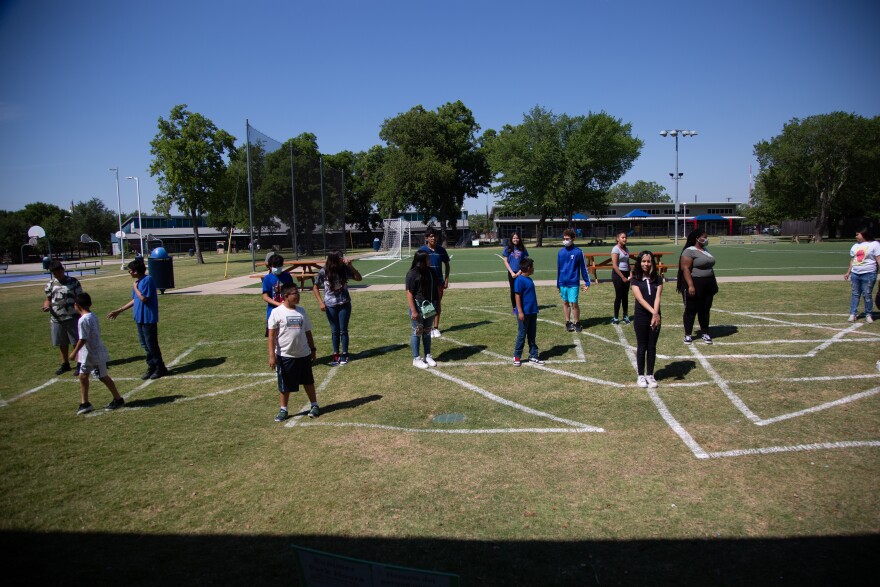The classroom was quiet.
Some of the fourth and fifth graders stared blankly at the sheets of graph paper set in front of them. Others snuck glances at the kids playing four-square just outside the window at Jubilee Park Community Center.
The kids are here for the center’s summer camp. And Joshua King, the co-founder of Dallas arts group Aurora, is leading art classes.
Over two days, students of different grade levels will file into the classroom. Watching them create artwork of their own revealed themes about the creative process that all of us can relate to.
First up for these fourth graders? Making a list of important moments in their lives, then drawing out timelines. Say something about any meaningful point in your life, King asked. The birth of a younger sibling, the loss of a beloved pet.
Nobody volunteered to speak.
King and the other instructors waited a few minutes. Then they sat down at each of the student tables. As the adults came down to their level, several of the students seemed far more eager to discuss their life experiences. Some, though, were “too cool” to interact with the project.
We all sometimes have problems getting started.

Choosing a path
All of the students were participating in what King refers to as "the Line Project," an art exercise that asks participants to reflect on their lives and draw out their own timelines. After writing down a number of seminal life experiences, participants are asked to represent these moments in a web of interconnected lines. Longer lines are meant to represent more important life moments, shorter lines the more mundane.
The second group to give it a go were sixth, seventh and eighth graders.
These students engaged with the concept to a greater degree at the start of the class, and King was more willing in turn to coax information out of the kids, calling on those who didn't raise their hands.
The concept seemed to stick better with the teens than it did with the younger students. The point of the class, according to the artist, was to make the students reflect on seminal experiences in their life and create a visible representation of how the trajectory of their timeline changed due to certain events.
One of the teenagers, Angela, appreciated the opportunity to reflect on her experiences. Life, she said, is always “balanced between good and bad.”
She was quick to finish her list and diagram, focusing more time on the graffiti-inspired signature she drew on the bottom of the page. She follows a number of street artists on Instagram, and draws inspiration from them whenever she makes her own art.
Everyone makes art at their own pace, by their own rules.

Perfectly imperfect
The first and second graders roared into the classroom, still brimming with energy after P.E.
King decided on a different approach for this age group. He began in the same way at first, polling the class on important moments in their lives.
Every single hand in the room shot up; with every single voice begged the artist to call on them.
King began plotting out the piece on the wall with bright orange tape. He kept the eager students involved in the process, asking them to help him rip the tape once it was to a satisfactory length for the importance of the event.
Some students reveled in this process, giggling to their friends about making the artist pull the tape to the extent of his wingspan. King obliged, adhering the comically long strands of tape to the wall.
When the ten lines were placed on the wall and the group timeline was completed, King asked the class to follow along with the model he made to create their own timelines. Naturally, the majority of the children took a number of artistic liberties with their pieces.
Most of the students drew whatever they wanted. Characters from the video game "Among Us" showed up in several of the pieces, as did iconography from another popular game, "Fortnite".
Some students preferred to draw more abstract pieces. When asked what their work was supposed to represent, all replied with a cheery “I don’t know!”
Savannah, a 7-year-old at the camp, stuck closely to the guidelines laid out for her. She chose not to use the rulers that were laid out at every table, and instead drew all of her lines freehand.
“I like drawing, I got some sketchbooks from camp,” she said. Her view on making art is simple, yet often forgotten as one moves farther and farther from childhood.
“You made it," she said. "It doesn’t have to be perfect.”
It doesn't matter how others might view your art as long as you're happy with it.

Life lessons
The teenagers filed back into the classroom for the second day of art classes. King wanted to do a land-art project with the students, a large timeline on the grass behind the community center drawn with a pushcart that drops chalk dust.
King began the session by asking the teens to call out some notable events from their pasts, as well as some possible goals for their futures.
Each student named something from one of the categories, ranging from getting a first pet to wanting to go to a Cowboys game. One of the students said that he wanted to go to “universe.”
“You want to go to university?” asked one of the instructors. The student explained that he meant to say Universal Studios, the theme park, to the amusement of all in the classroom.
After collecting a memory or an aspiration from all of the teens, the group marched outside to the grass in the park behind the building. The artist demonstrated how to use the chalk line drawer and explained that the length of each line should be equivalent to the importance of the thought. Then he let the kids take control.
The students were all excited to use the machine, grinning as they each drew their lines.
One teen's memory was that his grandfather passed away. They were very close. The student stoically walked forward with the chalk machine, stopping at a point where he thought the line was satisfactory. His line was longer than all the others.
“I think it’s huge to introduce kids to as many different creative processes as possible because you never know what’s going to connect with an individual,” said King.
“I think kids can handle complicated conceptual ideas,” he said, without having to “necessarily change or alter your body of work for a younger audience. Just speak to them as clearly and honestly as possible.”
When we make any kind of art, we draw from the key points in our life, the challenges we've faced, the obstacles we've overcome.
No matter our age, we can enjoy being creative and understand the power that art holds.







